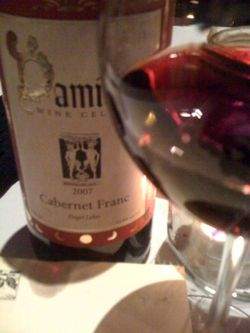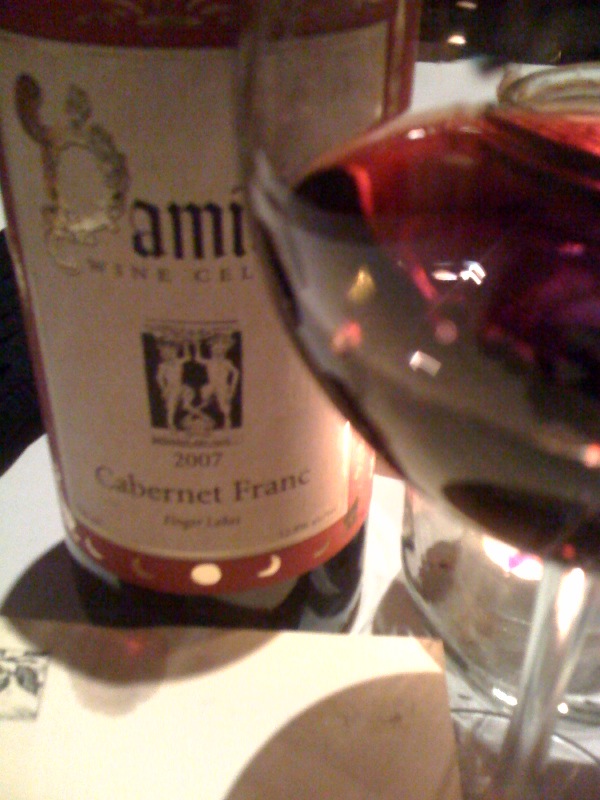 It had been two years since I last tasted the Damiani Wine Cellars 2007 Cabernet Franc, and I was down to my last bottle. On release, it was an impressive wine with depth, if a tad besmirched by oak. I liked it enough to buy three bottles.
It had been two years since I last tasted the Damiani Wine Cellars 2007 Cabernet Franc, and I was down to my last bottle. On release, it was an impressive wine with depth, if a tad besmirched by oak. I liked it enough to buy three bottles.
Earlier this month my wife and I went to dinner and decided to open this wine one more time.
Sometimes we talk about transformation that can occur in a complex wine, but no one really knows what to expect. If I harbored high hopes for the Damiani Cab Franc, it turns out those hopes were decidedly too low.
This wine was an absolute beauty, complex, layered, structured. It had gone from a pony to a wild stallion, from a Dodge Neon to an A8.
“That’s too bad,” I said, not disappointed in the wine by any stretch, but saddened at the thought that most of it was already sold and drunk.
This wine was released in 2009 when the components, while impressive, were still stitching themselves together. Imagine stopping by the automaker’s shop; the parts on the factory line appear built for power and elegance, but you can’t quite tell how it will come off as a finished product.
There’s no reason to doubt anymore. Damiani’s 2007 Cabernet Franc is simultaneously strong and graceful. It’s not a powerhouse on the scale of a warm climate wine, and it’s not meant to be. But it’s simply packed, a layered wine that peels off a new aroma and flavor every few seconds.
So why was it released so young? In that regard, there is nothing unique about this wine. Out of necessity, Finger Lakes wineries often release wines younger than they’d prefer to, whether it’s a riesling, a sparkling wine, or reds from warmer vintages (and 2007 was one of the special red wine vintages the region has ever seen). Margins are slim around here, and when a vintage sells out, often wineries need to put the next vintage on the shelf simply to keep cash flowing.
I asked Damiani co-owner Glenn Allen if that was the case with the 2007 Cabernet Franc.
“Yes,” he replied. “Often it is the case that a wine released early is just a few months away from being sufficiently open to enjoy it as a young wine.”
But Allen feels that the recent warmer vintages (2007 and 2010) have produced wines capable of opening up shortly after bottling. “There are many who like or prefer their wines young, full of bright fruit and vibrant tannins, so it’s always debatable when is the best time to release a wine,” he explained. “Especially with the 2007 vintage, releasing them early was not so much of a regret.”
Production was relatively low for many Finger Lakes wineries in 2007, and that’s true for Damiani as well. The result is a wine that disappeared rather quickly. Fortunately, Damiani is beginning to build a library, including seven cases of the 2007 Cab Franc.
“We’re trying to library more of our age-worthy wines from each vintage,” Allen said, adding that this practice is “both for our personal cellars and for re-releasing to our wine club members. We also now pour some samples of library wines at our tasting room, using a wine preservation system that keeps the wine intact.” Most recently, Damiani’s tasting room featured its 2004 red wines.
Allen guessed that the ’07 Cab Franc would peak at five years old, cruising right along for another five. That means that it is only now approaching its prime. What a shame that most of this wine was gone before customers could see it rise to its current height.
And where does it go next? As we’ve written about previously, no one can say with certainty, but that’s part of the fun. Damiani will have to decide carefully when to release its remaining bottles.
How to change the trend that sees so many wines released so young? Allen said it starts with educating customers about wine’s potential. “I always let people know that a young wine will become even better if they lay it down for awhile,” he said. “If they buy a few different wines, say including some whites, I suggest to them that they drink the young wine last.”
But so often, wines are released according to financial needs of the winery. No one should knock a winery for this practice if it’s truly a matter of economic necessity. I’ve spoken to countless winemakers and winery owners who wish they could wait a while with a special riesling or a structured red. But bills have to be paid, and for those of us who are only consuming the wines and not financing its creation, it’s easy to criticize. Better to remind winery owners, gently, that building a library - when feasible - is a wonderful idea. Exhibit A is Damiani’s 2007 Cabernet Franc, if you can find it.

